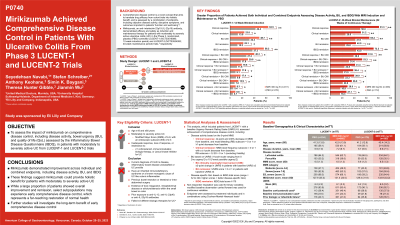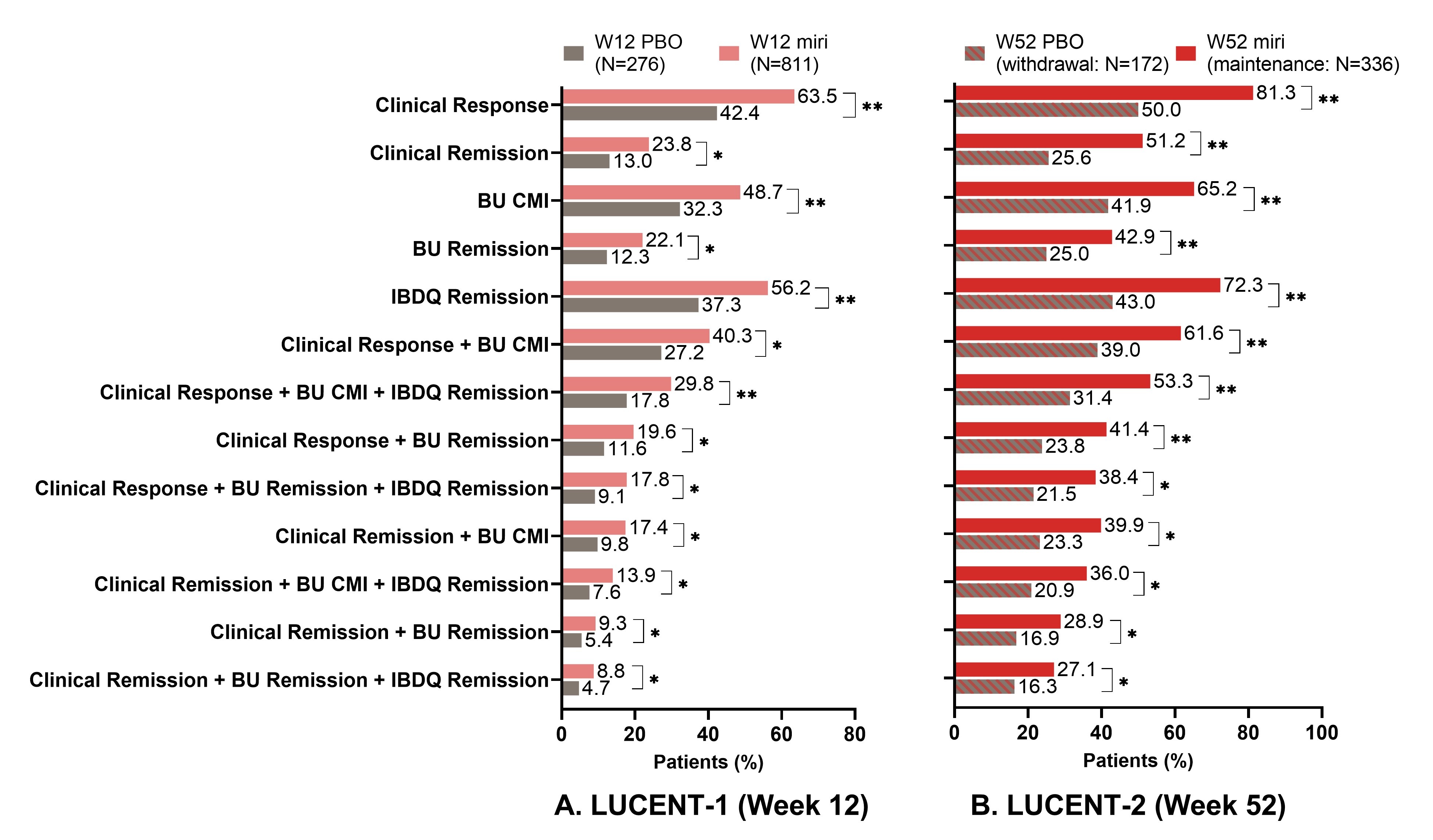Sunday Poster Session
Category: IBD
P0740 - Mirikizumab Achieved Comprehensive Disease Control in Patients With Ulcerative Colitis From Phase 3 LUCENT-1 and LUCENT-2 Trials
Sunday, October 22, 2023
3:30 PM - 7:00 PM PT
Location: Exhibit Hall

Has Audio
- SN
Seyedehsan Navabi, MD
United Medical Doctors
Long Beach, California
Presenting Author(s)
Seyedehsan Navabi, MD1, Stefan Schreiber, MD2, Anthony Keohane, MSc3, Simin Baygani, MS3, Theresa Hunter Gibble, PhD, MPH3, Jianmin Wu, PhD3
1United Medical Doctors, Long Beach, CA; 2University Hospital Schleswig Holstein, Kiel, Schleswig-Holstein, Germany; 3Eli Lilly and Company, Indianapolis, IN
Introduction: Mirikizumab (miri), an anti-IL-23p19 antibody, demonstrated efficacy and safety for moderately to severely active ulcerative colitis (UC) in the Phase 3 LUCENT-1 (NCT03518086) and LUCENT-2 (NCT03524092) trials. Comprehensive disease control (CDC) is a novel outcome combining stringently defined singular endpoints to describe holistic patient benefit. This analysis assessed the achievement of CDC, including disease activity, bowel urgency (BU), and quality of life assessed by the Inflammatory Bowel Disease Questionnaire (IBDQ), in patients with UC treated with miri versus placebo (PBO).
Methods: In LUCENT-1, patients were randomized 3:1 to miri 300 mg IV or PBO every 4 weeks (Q4W); miri-treated patients with clinical response at week (W)12 were re-randomized 2:1 to subcutaneous miri 200 mg or PBO Q4W for 40W in LUCENT-2 (52W continuous treatment). In patients with bowel Urgency Numeric Rating Scale (UNRS) ≥3 at baseline of LUCENT-1, endpoints at W12 and W52 included clinical response and remission based on the modified Mayo Score, BU clinically meaningful improvement (CMI; UNRS score ≥3-point change), BU remission (UNRS score 0 or 1), and IBDQ remission (total score ≥170). Endpoints were assessed by treatment (miri versus PBO) individually and in combinations using Cochran-Mantel-Haenszel tests.
Results: At W12 and W52, greater proportions of miri-treated versus PBO patients achieved all individual and combined endpoints using clinical response, clinical remission, BU CMI, BU remission, and IBDQ remission (Fig. 1; p< 0.05). The proportions of patients achieving clinical response in combination with other endpoints at W52 were [miri, PBO, p-value]: BU CMI [61.6%, 39.0%, < 0.0001], BU CMI and IBDQ remission [53.3%, 31.4%, < 0.0001], BU remission [41.4%, 23.8%, < 0.0001]), BU remission and IBDQ remission [38.4%, 21.5%, < 0.05]. The proportions of patients achieving clinical remission in combination with other endpoints at W52 were [miri, PBO, p-value]: BU CMI [39.9%, 23.3%, < 0.05], BU CMI and IBDQ remission [36.0%, 20.9%, < 0.05], BU remission [28.9%, 16.9%, < 0.05], BU remission and IBDQ remission [27.1%, 16.3%, < 0.05].
Discussion: Miri demonstrated substantial impact on CDC by achieving holistic combined endpoints including disease activity, bowel urgency, and IBDQ.

Disclosures:
Seyedehsan Navabi, MD1, Stefan Schreiber, MD2, Anthony Keohane, MSc3, Simin Baygani, MS3, Theresa Hunter Gibble, PhD, MPH3, Jianmin Wu, PhD3. P0740 - Mirikizumab Achieved Comprehensive Disease Control in Patients With Ulcerative Colitis From Phase 3 LUCENT-1 and LUCENT-2 Trials, ACG 2023 Annual Scientific Meeting Abstracts. Vancouver, BC, Canada: American College of Gastroenterology.
1United Medical Doctors, Long Beach, CA; 2University Hospital Schleswig Holstein, Kiel, Schleswig-Holstein, Germany; 3Eli Lilly and Company, Indianapolis, IN
Introduction: Mirikizumab (miri), an anti-IL-23p19 antibody, demonstrated efficacy and safety for moderately to severely active ulcerative colitis (UC) in the Phase 3 LUCENT-1 (NCT03518086) and LUCENT-2 (NCT03524092) trials. Comprehensive disease control (CDC) is a novel outcome combining stringently defined singular endpoints to describe holistic patient benefit. This analysis assessed the achievement of CDC, including disease activity, bowel urgency (BU), and quality of life assessed by the Inflammatory Bowel Disease Questionnaire (IBDQ), in patients with UC treated with miri versus placebo (PBO).
Methods: In LUCENT-1, patients were randomized 3:1 to miri 300 mg IV or PBO every 4 weeks (Q4W); miri-treated patients with clinical response at week (W)12 were re-randomized 2:1 to subcutaneous miri 200 mg or PBO Q4W for 40W in LUCENT-2 (52W continuous treatment). In patients with bowel Urgency Numeric Rating Scale (UNRS) ≥3 at baseline of LUCENT-1, endpoints at W12 and W52 included clinical response and remission based on the modified Mayo Score, BU clinically meaningful improvement (CMI; UNRS score ≥3-point change), BU remission (UNRS score 0 or 1), and IBDQ remission (total score ≥170). Endpoints were assessed by treatment (miri versus PBO) individually and in combinations using Cochran-Mantel-Haenszel tests.
Results: At W12 and W52, greater proportions of miri-treated versus PBO patients achieved all individual and combined endpoints using clinical response, clinical remission, BU CMI, BU remission, and IBDQ remission (Fig. 1; p< 0.05). The proportions of patients achieving clinical response in combination with other endpoints at W52 were [miri, PBO, p-value]: BU CMI [61.6%, 39.0%, < 0.0001], BU CMI and IBDQ remission [53.3%, 31.4%, < 0.0001], BU remission [41.4%, 23.8%, < 0.0001]), BU remission and IBDQ remission [38.4%, 21.5%, < 0.05]. The proportions of patients achieving clinical remission in combination with other endpoints at W52 were [miri, PBO, p-value]: BU CMI [39.9%, 23.3%, < 0.05], BU CMI and IBDQ remission [36.0%, 20.9%, < 0.05], BU remission [28.9%, 16.9%, < 0.05], BU remission and IBDQ remission [27.1%, 16.3%, < 0.05].
Discussion: Miri demonstrated substantial impact on CDC by achieving holistic combined endpoints including disease activity, bowel urgency, and IBDQ.

Figure: Fig. 1. Proportion of patients achieving clinical response, clinical remission, bowel urgency clinical meaningful improvement (BU CMI), BU remission, Inflammatory Bowel Disease Questionnaire (IBDQ) remission, and a combination of endpoints at week (W)12 in LUCENT-1 induction [A] and at W40 in LUCENT-2 mirikizumab [miri] induction responders (continuous treatment up to W52) [B].
Clinical response is based on the modified Mayo Score (MMS) and defined as ≥2-point and ≥30% decrease from baseline, and rectal bleeding (RB) subscore = 0 or 1, or ≥1-point decrease from baseline. Clinical remission is defined as MMS stool frequency subscore = 0 or 1 with a ≥1-point decrease from baseline; RB subscore = 0; endoscopic subscore = 0 or 1 (excluding friability). BU was assessed using the Urgency Numeric Rating Scale (UNRS), an 11-point scale ranging from 0 (“no urgency”) to 10 (“worst possible urgency”), with both BU CMI (≥3-point change) and BU remission (UNRS score of 0 or 1), measured in patients with a baseline UNRS of ≥3. Quality of life (QoL) was measured using the IBDQ remission (IBDQ total score ≥ 170; higher scores indicate better disease specific QoL).
Analysis included patients with UNRS ≥3 at baseline of LUCENT-1.
*p<0.05, **p<0.0001 vs placebo [PBO] based on Cochran-Mantel-Haenszel tests adjusted by prior biologic or tofacitinib failure (yes/no), baseline corticosteroid use (yes/no), region (North America/Europe/Other), and BL disease activity (LUCENT-1 only; MMS: [4-6] or [7-9]) or induction remission status (LUCENT-2 only; yes/no).
Clinical response is based on the modified Mayo Score (MMS) and defined as ≥2-point and ≥30% decrease from baseline, and rectal bleeding (RB) subscore = 0 or 1, or ≥1-point decrease from baseline. Clinical remission is defined as MMS stool frequency subscore = 0 or 1 with a ≥1-point decrease from baseline; RB subscore = 0; endoscopic subscore = 0 or 1 (excluding friability). BU was assessed using the Urgency Numeric Rating Scale (UNRS), an 11-point scale ranging from 0 (“no urgency”) to 10 (“worst possible urgency”), with both BU CMI (≥3-point change) and BU remission (UNRS score of 0 or 1), measured in patients with a baseline UNRS of ≥3. Quality of life (QoL) was measured using the IBDQ remission (IBDQ total score ≥ 170; higher scores indicate better disease specific QoL).
Analysis included patients with UNRS ≥3 at baseline of LUCENT-1.
*p<0.05, **p<0.0001 vs placebo [PBO] based on Cochran-Mantel-Haenszel tests adjusted by prior biologic or tofacitinib failure (yes/no), baseline corticosteroid use (yes/no), region (North America/Europe/Other), and BL disease activity (LUCENT-1 only; MMS: [4-6] or [7-9]) or induction remission status (LUCENT-2 only; yes/no).
Disclosures:
Seyedehsan Navabi: Eli Lilly and Company – Advisory Committee/Board Member.
Stefan Schreiber: AbbVie – Consultant, Speakers Bureau. Arena – Consultant. Biogen – Advisory Committee/Board Member, Consultant. Bristol Myers Squibb, – Consultant, Speakers Bureau. Celgene – Consultant. Celltrion – Advisory Committee/Board Member, Consultant. Eli Lilly – Consultant, Speakers Bureau. Falk Pharma – Consultant, Speakers Bureau. Fresenius – Consultant. Galapagos/Gilead – Consultant, Speakers Bureau. Hikma – Consultant, Speakers Bureau. IMAB – Advisory Committee/Board Member, Consultant. Janssen – Consultant, Speakers Bureau. MSD – Consultant, Speakers Bureau. Mylan – Advisory Committee/Board Member, Consultant. Pfizer – Consultant, Speakers Bureau. Protagonist – Consultant. Provention Bio – Consultant. Takeda – Consultant, Speakers Bureau. Theravance – Consultant.
Anthony Keohane indicated no relevant financial relationships.
Simin Baygani: Eli Lilly and Company – Employee, Stock Options.
Theresa Hunter Gibble: Eli Lilly and Company – Employee, stockholder.
Jianmin Wu: Eli Lilly and Company – Employee, Stock Options.
Seyedehsan Navabi, MD1, Stefan Schreiber, MD2, Anthony Keohane, MSc3, Simin Baygani, MS3, Theresa Hunter Gibble, PhD, MPH3, Jianmin Wu, PhD3. P0740 - Mirikizumab Achieved Comprehensive Disease Control in Patients With Ulcerative Colitis From Phase 3 LUCENT-1 and LUCENT-2 Trials, ACG 2023 Annual Scientific Meeting Abstracts. Vancouver, BC, Canada: American College of Gastroenterology.
